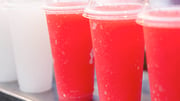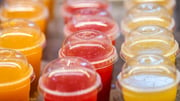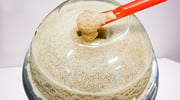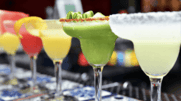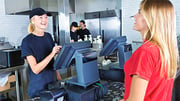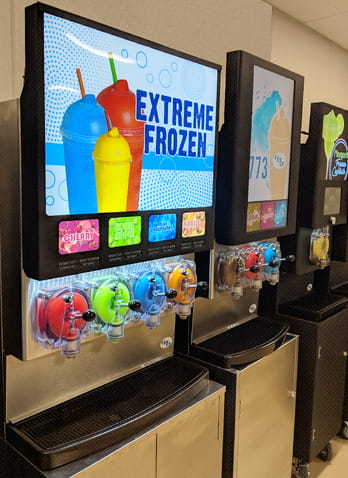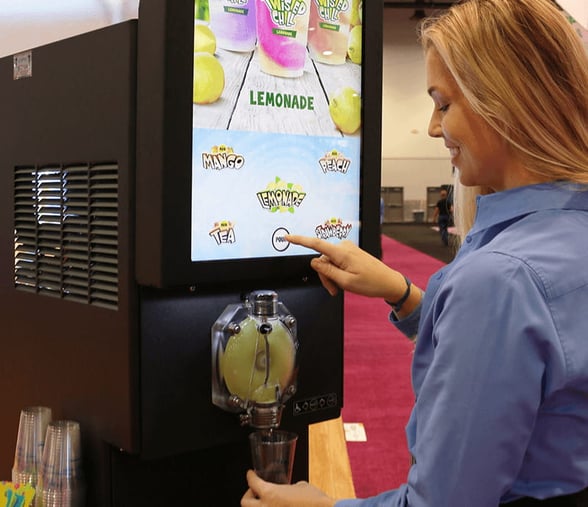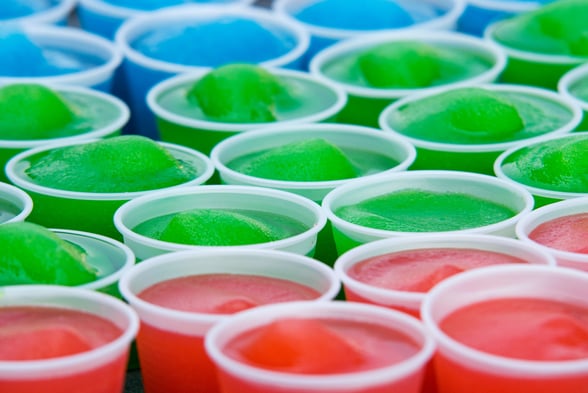There’s no doubt that frozen drink machines are wildly popular. They put a new twist on old favorites like fruit juice, soda, and coffee. What you may not realize though, is that there are distinct differences between a frozen beverage machine and a regular slushie machine. We’ll explain the difference in a minute, but what we really want to talk about is which machine can bring you more customers.
What’s the Difference Between Frozen Beverage and Slushies?
While all frozen drinks may seem similar to one another, there’s a fundamental difference in how the frozen state is achieved that makes the difference between a ‘frozen beverage’ and a ‘slushie.’
Frozen Beverage Machines
A frozen beverage machine is designed to rapidly freeze liquid beverages to form tiny ice crystals. This technology creates a smooth beverage that doesn’t separate from the ice. Frozen beverage machines can be carbonated or noncarbonated with the addition of CO2 being the key difference.
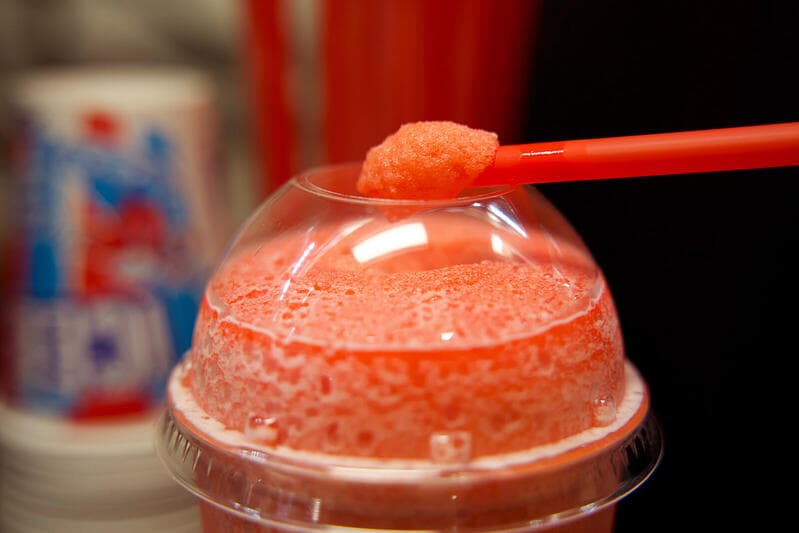
Slushie Machines
A slushie machine freezes water to create shaved, crushed, or pulverized ice. That ice is then combined with a flavor mix, typically something fruity and loaded with sugar. If you’ve had a frozen beverage where it is easy to suck the flavor out of the ice, you’ve had a slushie. Slushies can be great - as a high-quality Italian Ice, but they can also be pretty basic.
How to Make Money from Your Slushie Machine
How much money you make from your frozen drinks depends on a few factors. For one, the cost of the equipment will determine how quickly you reach profitability. Slushie machines tend to be less expensive upfront, leading to quicker profitability. But, frozen beverage machines win in the long run providing longer lifespans and lower supply costs.
The good news is that sales are up for frozen beverages. One in three consumers reports purchasing more frozen beverages now compared to the last few years. And that’s because these drinks are now available in a wider variety of more exciting flavors!
Another factor that contributes to making money is marketing. Both slush and frozen beverage machines can see similar sales performance based on their marketing tactics. For the average consumer, there is little difference between the two. As long as you are offering interesting flavors, a competitive price, and can spread the word to generate interest, your drinks will sell.
We recommend trying out these sales tactics to get things moving:
- Invest in large, attractive, colorful signage that draws attention to your new drinks
- Run special promotions to boost sales and encourage associates to upsell on every transaction
- Generate more foot traffic by launching social media campaigns and other advertising activities
- Carefully plan the timing of your new product launch as temperatures rise for the warmer season
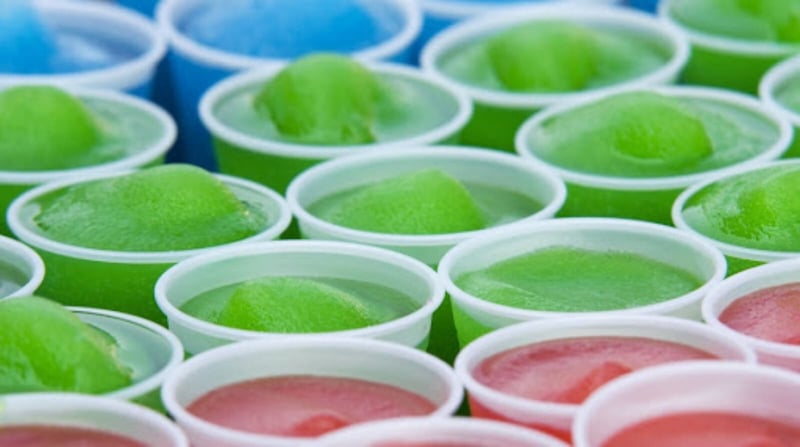
Start Planning Your Product Launch Today
It’s easy to get swept away in the possibilities of 70% - 120% profits. But before you get out the checkbook and buy the most expensive slushie machine or frozen beverage machine on the market, consider your needs first.
Choose the Right Machine for Your Business
There are different sizes to accommodate different needs. Consider how much traffic your business is currently receiving and what factors affect your traffic patterns. Maybe the size of your business is prohibitive or business ebbs and flows with community events. Your needs, physical space, and staffing levels will factor into your machine choice.
Plan for Maintenance and Downtime
Different price points often reflect variations in the quality of parts and construction. Do your homework and find out how many parts the machine uses and how long they last. The manufacturer should be able to provide some warranty-backed stats on repair costs, maintenance needs, and expected downtime.
Consider Day-to-Day Operation
Consider who will have the most contact with your drink machine. If staff will be dispensing drinks for customers, do you have enough people? And if you will set the machine up for self-service, how will you keep the area clean?
Work Out the Product Details
It’s the standard lineup of questions. Figure out what flavors you will offer, who your competition for frozen drinks is, and how you will package, market, and price your new beverage product. There are no hard-and-fast rules. In fact, you might find that certain flavors have cyclical popularity and others have regional popularity. It’s okay to experiment until you find the right flavors that maximize your profits. Just make sure that you’re setting sales goals and culling unpopular flavors before they cut into your profits.
Here’s the Quickest Way to Recoup Your Investment
While a frozen beverage machine boasts simple operation, the set it and forget it approach may not work unless you have prime counter real estate with heavy foot traffic. But of course, if you’re in that position you probably aren’t looking for ways to squeeze a little more cash out of your business.
So, here’s what to do instead:
Plan a Strategy
Before you put cash down on a drink machine, make a plan for how and when you will use it. If you’re planning to do a fundraiser or open a drink cart, figure out how many events you need to do to pay for the machine. This means you’ll need an idea of how many drinks will be on your menu, costs for cups, straws, and napkins, and how much you will charge per beverage.
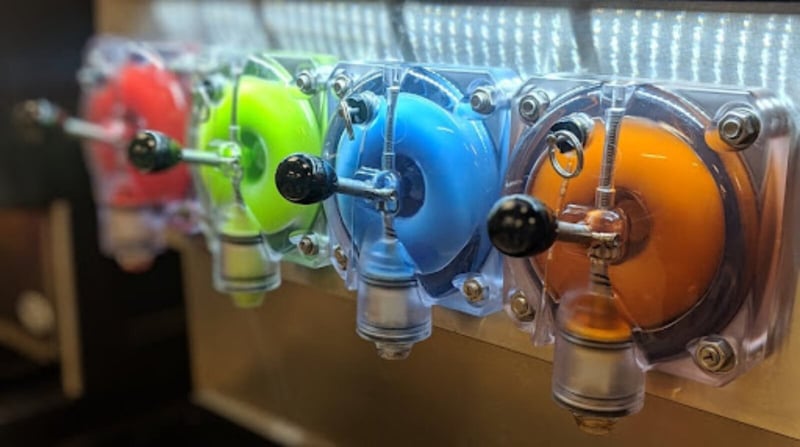
Find the Best Selling Price
How much do people pay for a frozen beverage? The answer actually varies significantly depending on where you’re located. Like any business, you’ll need to dig into some market research to find out what’s selling and what customers are paying for a drink.
From there, it’ll take a little bit of experimentation to find the right price for your product. Of course, you’ll need to cover your costs. And you’ll likely sell drinks at higher or lower prices. But the goal is to find that sweet spot where you are making the most sales at the highest sustainable price without seeing a drop in sales.
Coordinate Timing
As we mentioned before, the demand for frozen beverages is seasonal. If you launch a new machine in the middle of a blizzard, your sales will be noticeably absent. If you can plan your product launch to coincide with the summer months and trigger special promos during heat waves, you’ll be off to a strong start.
Get the Word Out
Sometimes we get so excited about the new product that we forget to let our customers know we have it. Don’t let your new product launch fall flat because your regular foot traffic didn’t notice the new beverage machine sitting on the counter.
We recommend making a really big deal about it. Create oversized signage with bright colors and an attractive design that features product pictures of your new beverages. And then, put them everywhere. In the windows, at the entrance, at the cash register, on the cooler doors for regular beverages, and by the new machine. Get your employees talking about the new drinks, blast promos on social media, and keep things fresh by rotating flavors.
How to Calculate your Slushie Machine’s ROI
Knowing your return-on-investment (ROI) is key to running a profitable business. This metric tells you how long it will take for new investment (your slushie machine) to pay for itself and maximize profits that contribute to growing your bottom line.

Understanding Your Costs
As you mull over the idea of adding a slushie machine or frozen beverage machine to your business, you’re probably focusing on the sticker price of that machine as your upfront cost. But there’s a little more that goes into it. What about:
- Training Needs
- Cleaning, Maintenance, and Downtime
- Supply Costs like Syrup, Cups, Straws, and Lids
- Utility Costs like Water & Electricity
- Durability and Replacement Costs
- Impact on Customer Satisfaction & Other Sales Categories
Sales Projections
The next data set that you need to calculate your ROI is anticipated sales volume. Those numbers are going to look very different for a quick-service food stand on the boardwalk of a popular beach than they will for a gas station convenience store in a small midwestern town. Whatever is realistic for your business is what is important.
Use your current sales volume and customer count to calculate projections for what percentage might also buy your new drinks. Roughout some competitive pricing and calculate your serving sizes to see how many beverages you can sell per bag of drink mix. And then begin crunching the numbers to see how many sales you can realistically make in a week, month, quarter, or year.
Take your costs and your sales projections and map out a timeline to see how long it will take your machine to pay for itself and reach peak profitability. Or, use this ROI calculator and plug your numbers in.
Examples of One-Year Profits
What do the numbers actually look like in a typical year for the average small business? Let’s take a look at an example.
For equipment, you will want to offer at least two flavors. That means purchasing two single machines or one machine with the capacity for two or more flavors. We anticipate that a budget-friendly machine will cost around $2K and you might spend another $2-3K training staff and printing marketing materials for a total startup cost of $5K.
You’ll need some supplies, like drink mix at an average of 2 cents per ounce and packaging at an average of 10 cents per beverage. And utilities are minimal, you can expect an extra $250-$300 on your bills over the course of a year. When we average the costs out, you’re spending $0.50 per beverage. Assuming a 10% margin for waste and downtime, this is what your ROI looks like over the first year:
A small concession stand that averages 30 sales per day or 210 sales per week at $2.00 per beverage will reach profitability in an average of 151 days (less than six months).
A moderately busy convenience store that averages 500 sales per week at $2.50 per beverage will reach profitability in an average of 91 days (about three months).
A high-traffic movie theater concession that averages more than 1000 sales per week at $4.00 per beverage will reach profitability in an average of 31-45 days (a little over one month).
Set up a profitable frozen program, specific to your unique needs. Start Your Frozen Program
Conclusion
If you’re considering getting involved with the frozen beverage industry, you will soon notice that carbonated frozen drinks are rapidly increasing in popularity, taking regular slushies off the throne. They add a new twist to standard treats, come with minimal effort and maximum profit, and their machines require very little maintenance.
At FBD, we pride ourselves on helping our customers find a tailored solution that’s perfect for their companies. Contact us today and make an informed decision that will bring you boosted profits and happy customers.
Looking for more information? Check out our Frequently Asked Questions below, or take a look at Guide To Setting Up A Frozen Beverage Program.
FAQ
If you’re not sold on the idea of adding a frozen beverage machine, it’s probably because you still have questions. Here are some common sticking points for business owners who are stuck on the idea of adding frozen drinks.
Are slush machines profitable?
Yes. It’s an easy claim to back up given that the cost of equipment is minimal (around $2K per machine), supplies are affordable (around $0.10 per drink), and minimal maintenance and labor are needed. All things considered, your cost for the average 16 oz. slushie is around $0.50-$0.60 per serving and drinks commonly sell for between $2.50-$4.00 apiece. That puts slushies squarely in the green for profitability.
How do frozen drink machines work?
A frozen drink machine typically works by using a rapid freezing technology to turn liquid beverages (with or without carbonation) into tiny ice crystals.
Will a slushie machine freeze water?
There is an art to creating the perfect slushie texture. It isn’t quite frozen—at least not solid. These machines work by constantly moving liquid over a cooling surface and then moving it away before the molecules have time to fully bond. But sugar, which is found in the syrup, is essential for the proper cooling process. Without it, you probably won’t get satisfactory results. Depending on how the machine is designed, it might freeze plain water but the consistency would definitely be off.
What is a frozen drink dispenser?
A frozen drink dispenser is a machine that includes a cooling or freezing mechanism, a vat for holding a prepared beverage, and a dispensing system to fill cups with the desired beverage. This includes both slushie machines and FCB or FUB machines. The key difference between the two is the freezing technology. Slushie machines work similarly to most ice makers where a cooling mechanism chills liquid to a cold enough temperature to freeze. FCB and FUB machines use rapid freezing technology to instantly freeze liquids.
Can you put alcohol in a slushie machine?
Yes. Frozen margaritas and frozen daiquiris at your favorite restaurants are likely served out of similar machines. Just keep an eye on your math to make sure you’re keeping alcohol at a ratio of two ounces per serving to keep your patrons happy.





